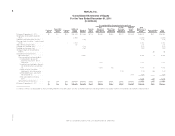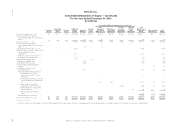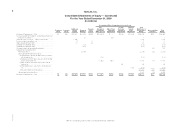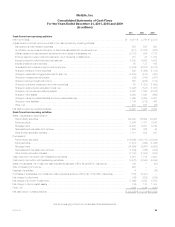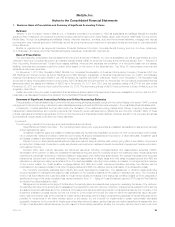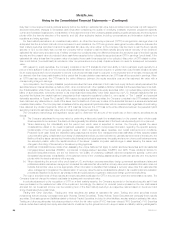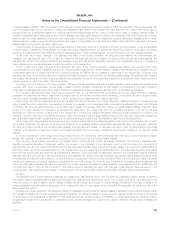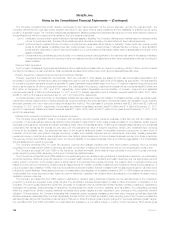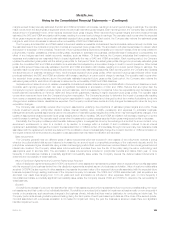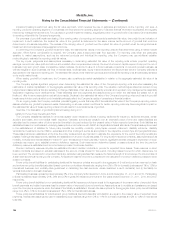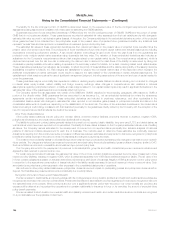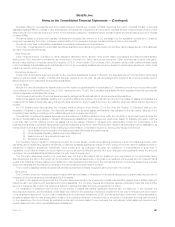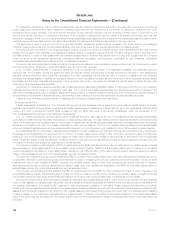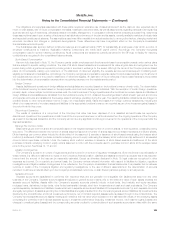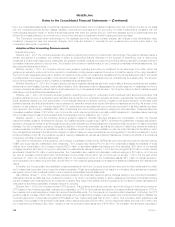MetLife 2011 Annual Report Download - page 104
Download and view the complete annual report
Please find page 104 of the 2011 MetLife annual report below. You can navigate through the pages in the report by either clicking on the pages listed below, or by using the keyword search tool below to find specific information within the annual report.MetLife, Inc.
Notes to the Consolidated Financial Statements — (Continued)
The estimated fair value of residential mortgage loans held-for-sale and securitized reverse residential mortgage loans are primarily based on
observable pricing for securities backed by similar types of loans, adjusted to convert the securities prices to loan prices, or from independent broker
quotations, which is intended to approximate the amounts that would be received from third parties. Certain other mortgage loans designated as
held-for-sale are recorded at the lower of amortized cost or estimated fair value, or for collateral dependent loans, estimated fair value of the collateral
less expected disposition costs. For these loans, estimated fair value is determined using independent broker quotations or values provided by
independent valuation specialists or, when the loan is in foreclosure or otherwise collateral dependent, the estimated fair value of the underlying collateral
is estimated using internal models.
The estimated fair value of MSRs is principally determined through the use of internal discounted cash flow models which utilize various valuation
inputs and assumptions which are described in Note 5. The use of different valuation assumptions and inputs, as well as assumptions relating to the
collection of expected cash flows, may have a material effect on the estimated fair values of MSRs.
Financial markets are susceptible to severe events evidenced by rapid depreciation in asset values accompanied by a reduction in asset liquidity.
The Company’s ability to sell securities, or the price ultimately realized for these securities, depends upon the demand and liquidity in the market and
increases the use of judgment in determining the estimated fair value of certain securities.
The determination of the amount of valuation allowances and impairments, as applicable, is described previously by investment type. The
determination of such valuation allowances and impairments is highly subjective and is based upon the Company’s periodic evaluation and assessment
of known and inherent risks associated with the respective asset class. Such evaluations and assessments are revised as conditions change and new
information becomes available.
The recognition of income on certain investments (e.g. structured securities, including mortgage-backed and ABS, certain structured investment
transactions, trading and other securities) is dependent upon prepayments and defaults, which could result in changes in amounts to be earned.
The Company has invested in certain structured transactions that are VIEs. These structured transactions include asset-backed securitizations,
hybrid securities, real estate joint ventures, other limited partnership interests, and limited liability companies. The Company consolidates those VIEs for
which it is deemed to be the primary beneficiary.
The accounting guidance for the determination of when an entity is a VIE and when to consolidate a VIE is complex and requires significant
management judgment. The determination of the VIE’s primary beneficiary requires an evaluation of the contractual and implied rights and obligations
associated with each party’s relationship with or involvement in the entity, an estimate of the entity’s expected losses and expected residual returns and
the allocation of such estimates to each party involved in the entity. The Company generally uses a qualitative approach to determine whether it is the
primary beneficiary.
For most VIEs, the entity that has both the ability to direct the most significant activities of the VIE and the obligation to absorb losses or receive
benefits that could be significant to the VIE is considered the primary beneficiary. However, for VIEs that are investment companies or apply
measurement principles consistent with those utilized by investment companies, the primary beneficiary is based on a risks and rewards model and is
defined as the entity that will absorb a majority of a VIE’s expected losses, receive a majority of a VIE’s expected residual returns if no single entity
absorbs a majority of expected losses, or both. The Company reassesses its involvement with VIEs on a quarterly basis. The use of different
methodologies, assumptions and inputs in the determination of the primary beneficiary could have a material effect on the amounts presented within the
consolidated financial statements.
Derivative Financial Instruments
Derivatives are financial instruments whose values are derived from interest rates, foreign currency exchange rates, credit spreads and/or other
financial indices. Derivatives may be exchange-traded or contracted in the over-the-counter (“OTC”) market. The Company uses a variety of derivatives,
including swaps, forwards, futures and option contracts, to manage various risks relating to its ongoing business operations. To a lesser extent, the
Company uses credit derivatives, such as credit default swaps, to synthetically replicate investment risks and returns which are not readily available in
the cash market. The Company also purchases certain securities, issues certain insurance policies and investment contracts and engages in certain
reinsurance agreements that have embedded derivatives.
Freestanding derivatives are carried in the Company’s consolidated balance sheets either as assets within other invested assets or as liabilities within
other liabilities at estimated fair value as determined through the use of quoted market prices for exchange-traded derivatives and interest rate forwards
to sell certain to be announced securities or through the use of pricing models for OTC derivatives. The determination of estimated fair value of
freestanding derivatives, when quoted market values are not available, is based on market standard valuation methodologies and inputs that
management believes are consistent with what other market participants would use when pricing the instruments. Derivative valuations can be affected
by changes in interest rates, foreign currency exchange rates, financial indices, credit spreads, default risk, nonperformance risk, volatility, liquidity and
changes in estimates and assumptions used in the pricing models.
Accruals on derivatives are generally recorded in accrued investment income or within other liabilities in the consolidated balance sheets. However,
accruals that are not expected to settle within one year are included with the derivative carrying value in other invested assets or other liabilities.
The Company does not offset the fair value amounts recognized for derivatives executed with the same counterparty under the same master netting
agreement.
If a derivative is not designated as an accounting hedge or its use in managing risk does not qualify for hedge accounting, changes in the estimated
fair value of the derivative are generally reported in net derivative gains (losses) except for those (i) in policyholder benefits and claims for economic
hedges of variable annuity guarantees included in future policy benefits; (ii) in net investment income for (a) economic hedges of equity method
investments in joint ventures, (b) all derivatives held in relation to the trading portfolios, and (c) derivatives held within contractholder-directed unit-linked
investments; (iii) in other revenues for derivatives held in connection with the Company’s mortgage banking activities; and (iv) in other expenses for
economic hedges of foreign currency exposure related to the Company’s international subsidiaries. The fluctuations in estimated fair value of derivatives
which have not been designated for hedge accounting can result in significant volatility in net income.
To qualify for hedge accounting, at the inception of the hedging relationship, the Company formally documents its risk management objective and
strategy for undertaking the hedging transaction, as well as its designation of the hedge as either (i) a hedge of the estimated fair value of a recognized
asset or liability (“fair value hedge”); (ii) a hedge of a forecasted transaction or of the variability of cash flows to be received or paid related to a
100 MetLife, Inc.


